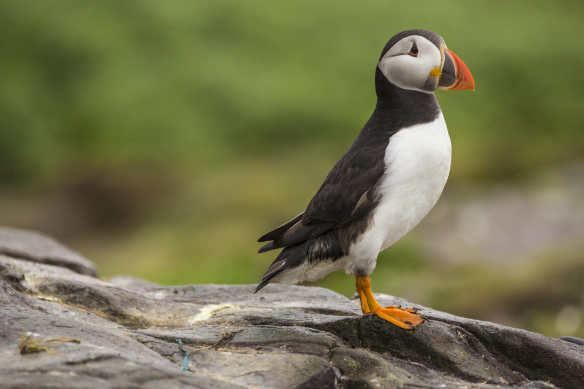North Sea puffins will take on Dorset lizards this month, as two National Trust nature reserves go head to head in a battle to be crowned Countryfile Magazine’s Nature Reserve of the Year.
The Farne Islands, off the Northumberland coast, and Dorset’s Studland Heath National Nature Reserve appear on the shortlist of five nature reserves chosen by BBC Radio 4 presenter Brett Westwood.

A puffin on the Farne Islands, Northumberland. The Farne Islands has 23 nesting species of seabird, including thousands of puffins.
Countryfile Magazine readers have until 28 February to vote for their favorite reserve. And National Trust reserve managers have already been pressing their claims to the crown.
Gwen Potter, countryside manager on the Northumberland Coast, manages the Farne Islands. Sitting a over a mile off the Northumberland coast, the islands are home to around 37,000 pairs of puffins – as well as a team of rangers who live full-time on the islands for six months every year.
Gwen, who was previously a ranger in mid-Wales, said: “When you arrive on the Farne Islands by boat what first hits you is the smell of more than 82,000 pairs of birds. But the smell is soon forgotten when you feel Arctic terns swoop over your head, puffins waddling oblivious across the boardwalks and shags tripping over their own precious pieces of seaweed as they bring them back to their nest.
“The Farne Islands have had rangers for 189 years. These rangers have helped the islands to be what they are today – but they would be nothing without their seabirds and seals.”
But the Farne Islands face stiff competition from Studland Heath. The 1,500 hectare heathland on Dorset’s Isle of Purbeck boasts all six species of native reptiles – including sand lizards and adders.
David Brown, ecologist for the National Trust on Purbeck, said: “I don’t think there is anywhere else in Britain that better balances what a nature reserve is supposed to be. It is an inspiring breathing space for millions of visitors each year, yet it still retains a feeling of wildness and a breathtaking range of exceptional quality habitats for thousands of native species.
“Change is the only constant at Studland – as new dunes are constantly being formed that enclose lower lying wetter areas. As nature takes over they become colonized by some of our rarest plants and animals. We know of at least three species that occur here and nowhere else in England.”
Nature Reserve of the Year is just one of 12 categories in the Countryfile Magazine awards.
Among the landscapes cared for the National Trust up for awards are:
- Embleton Bay, Northumberland (Beach of the Year). Cared for by the Trust since 1961, the huge stretch of sandy beach offers views of imposing Dunstanburgh Castle – as well as glimpses of rare wildlife such as otter, little tern, purple milk-vetch, grey partridge and hare.
- Malhamdale, Yorkshire Dales (Holiday Destination of the Year). Limestone cliffs tower over the beck and fields at Malhamdale, near Skipton. It’s a short walk from Malhamdale is England’s highest freshwater lake, Malham Tarn – home to otters and water voles.
- Porthucurno, Cornwall (Beach of the Year). Underneath this famous Cornish beach once ran the first submarine telegraph cables – used for sending messages from Britain to India. The beach was donated to the National Trust by the Cable and Wireless plc in 1994.
- Lake District (Landmark of the Year). National Trust rangers and tenant farmers care for a fifth of the fells and farmland in the Lake District National Park, including England’s highest peak Scafell Pike and Beatrix Potter’s home at Hill Top Farm.
- White Cliffs of Dover (Landmark of the Year). An iconic landscape, the best way to experience the White Cliffs is on a clifftop walk to South Foreland Lighthouse – built in 1843 and now in the care of the National Trust. If you’re visiting in summer you might catch a glimpse of the chalkhill blue butterfly and pyramidal orchid.
Polls for the Countryfile Magazine awards close on 28 February. To vote visit www.countryfile.com/awards.



